check engine light MITSUBISHI SHOGUN 2008 Owner's Manual (in English)
[x] Cancel search | Manufacturer: MITSUBISHI, Model Year: 2008, Model line: SHOGUN, Model: MITSUBISHI SHOGUN 2008Pages: 538, PDF Size: 25.09 MB
Page 137 of 538
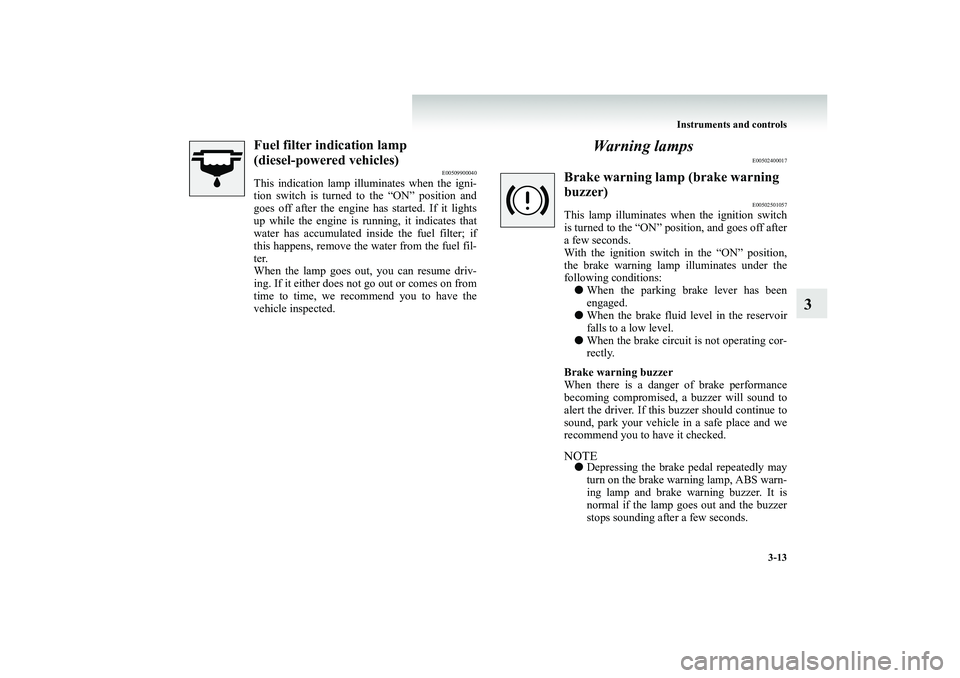
Instruments and controls
3-13
3
Fuel filter indication lamp (diesel-powered vehicles)
E00509900040
This indication lamp illuminates when the igni- tion switch is turned to the “ON” position andgoes off after the engine has started. If it lights up while the engine is ru
nning, it indicates that
water has accumulated inside the fuel filter; ifthis happens, remove the
water from the fuel fil-
ter. When the lamp goes out, you can resume driv-ing. If it either does not go out or comes on from time to time, we recommend you to have the vehicle inspected.
Wa r n i n g l a m p s
E00502400017
Brake warning lamp (brake warning buzzer)
E00502501057
This lamp illuminates when the ignition switch is turned to the “ON” position, and goes off after a few seconds.With the ignition switch in the “ON” position, the brake warning lamp illuminates under the following conditions:●
When the parking brake lever has been engaged.
●
When the brake fluid level in the reservoir falls to a low level.
●
When the brake circuit
is not operating cor-
rectly.
Brake warning buzzer When there is a danger of brake performance becoming compromised,
a buzzer will sound to
alert the driver. If this
buzzer should continue to
sound, park your vehicl
e in a safe place and we
recommend you to have it checked.NOTE●
Depressing the brake pe
dal repeatedly may
turn on the brake warning lamp, ABS warn- ing lamp and brake
warning buzzer. It is
normal if the lamp goes out and the buzzer stops sounding after a few seconds.
BK-BK2008E1ENUK.en-uk-Section6.fm Page
13 Wednesday, January 9, 2008 4:32 PM
Page 182 of 538
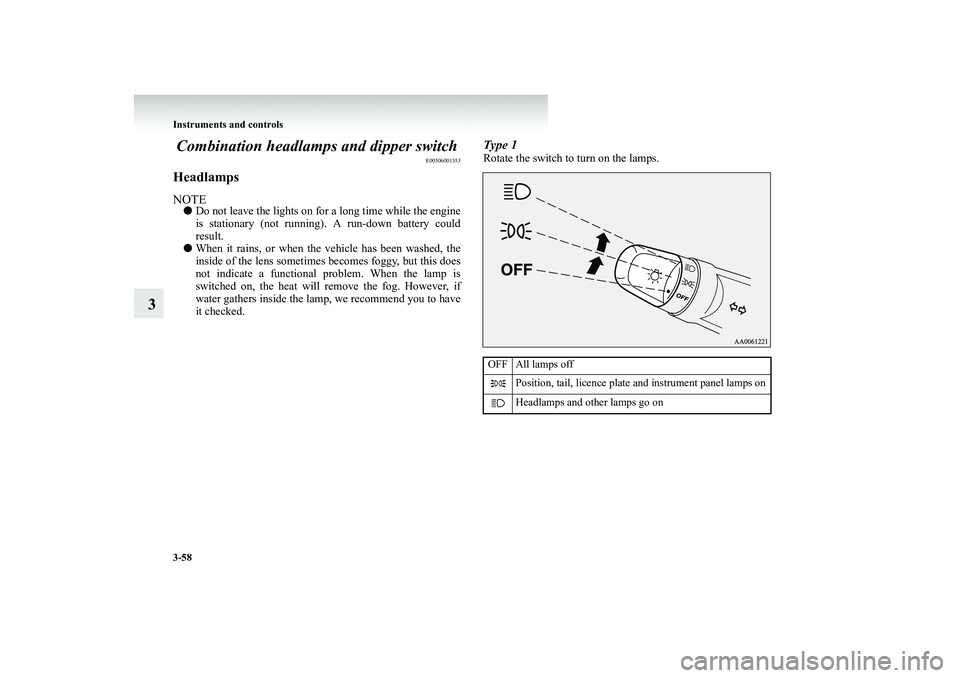
3-58 Instruments and controls
3
Combination headlamps
and dipper switch
E00506001353
HeadlampsNOTE●
Do not leave the lights on for a long time while the engine is stationary (not running). A run-down battery could result.
●
When it rains, or when the
vehicle has been washed, the
inside of the lens sometimes becomes foggy, but this does not indicate a functional pr
oblem. When the lamp is
switched on, the heat will
remove the fog. However, if
water gathers inside the lamp, we recommend you to have it checked.
Type 1Rotate the switch to turn on the lamps.OFF All lamps off
Position, tail, licence plate and instrument panel lamps on Headlamps and other lamps go on
BK-BK2008E1ENUK.en-uk-Section6.fm Page
58 Wednesday, January 9, 2008 4:32 PM
Page 204 of 538
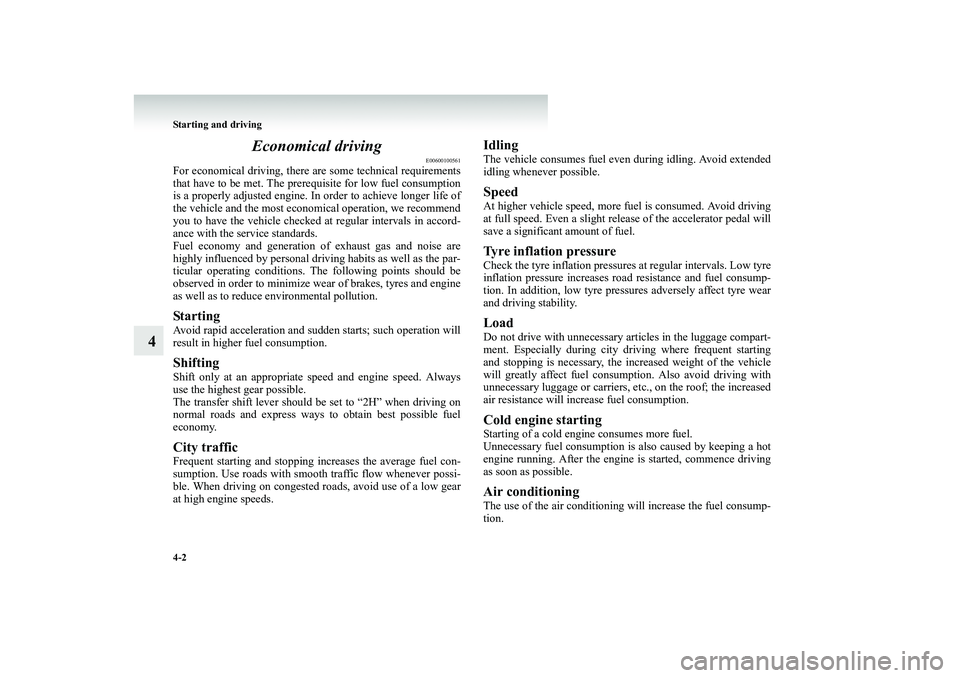
4-2 Starting and driving
4
Economical driving
E00600100561
For economical driving, there ar
e some technical requirements
that have to be met. The prerequisite for low fuel consumption is a properly adjusted engine. In order to achieve longer life ofthe vehicle and the most econo
mical operation, we recommend
you to have the vehicle checked
at regular intervals in accord-
ance with the service standards.Fuel economy and generation of exhaust gas and noise are highly influenced by personal driving habits as well as the par- ticular operating conditions. The following points should beobserved in order to minimize w
ear of brakes, tyres and engine
as well as to reduce environmental pollution.StartingAvoid rapid acceleration and sudden starts; such operation will result in higher fuel consumption.ShiftingShift only at an appropriate
speed and engine speed. Always
use the highest gear possible. The transfer shift lever should be set to “2H” when driving on normal roads and express ways to obtain best possible fueleconomy.City trafficFrequent starting and stopping
increases the average fuel con-
sumption. Use roads with smooth
traffic flow whenever possi-
ble. When driving on congested
roads, avoid use of a low gear
at high engine speeds.
IdlingThe vehicle consumes fuel even during idling. Avoid extended idling whenever possible.SpeedAt higher vehicle speed, more fu
el is consumed. Avoid driving
at full speed. Even a slight re
lease of the accelerator pedal will
save a significant amount of fuel.Tyre inflation pressureCheck the tyre inflation pressure
s at regular intervals. Low tyre
inflation pressure increases ro
ad resistance and fuel consump-
tion. In addition, low tyre pres
sures adversely affect tyre wear
and driving stability.LoadDo not drive with unnecessary articles in the luggage compart- ment. Especially during city dr
iving where frequent starting
and stopping is necessary, the increased weight of the vehicle will greatly affect fuel consumption. Also avoid driving with unnecessary luggage or carriers,
etc., on the roof; the increased
air resistance will increase fuel consumption.Cold engine startingStarting of a cold engine consumes more fuel. Unnecessary fuel consumption
is also caused by keeping a hot
engine running. After the engine is started, commence driving as soon as possible.Air conditioningThe use of the air conditioning
will increase the fuel consump-
tion.
BK-BK2008E1ENUK.en-uk-Section7.fm Page 2 Wednesday, January 9, 2008 4:36 PM
Page 252 of 538
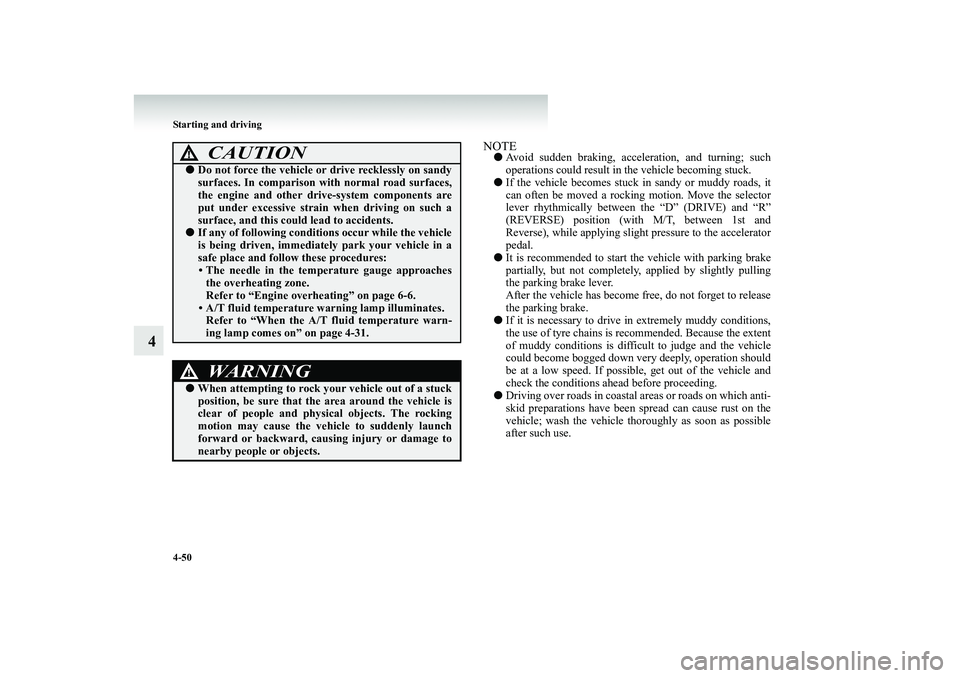
4-50 Starting and driving
4
NOTE●
Avoid sudden braking, acceler
ation, and turning; such
operations could result in the vehicle becoming stuck.
●
If the vehicle becomes stuck in sandy or muddy roads, it can often be moved a rocking motion. Move the selectorlever rhythmically between
the “D” (DRIVE) and “R”
(REVERSE) position (with M/T, between 1st and Reverse), while applying sli
ght pressure to the accelerator
pedal.
●
It is recommended to start th
e vehicle with parking brake
partially, but not completely, applied by slightly pullingthe parking brake lever. After the vehicle has become fr
ee, do not forget to release
the parking brake.
●
If it is necessary to drive in extremely muddy conditions, the use of tyre chains is recommended. Because the extent of muddy conditions is difficult to judge and the vehiclecould become bogged down very deeply, operation should be at a low speed. If possible
, get out of the vehicle and
check the conditions ah
ead before proceeding.
●
Driving over roads in coastal
areas or roads on which anti-
skid preparations have been
spread can cause rust on the
vehicle; wash the vehicle thoroughly as soon as possibleafter such use.
CAUTION
!●
Do not force the vehicle or drive recklessly on sandy surfaces. In comparison wi
th normal road surfaces,
the engine and other driv
e-system components are
put under excessive strain
when driving on such a
surface, and this coul
d lead to accidents.
●
If any of following conditions occur while the vehicle is being driven, immediatel
y park your vehicle in a
safe place and follow these procedures:• The needle in the temp
erature gauge approaches
the overheating zone. Refer to “Engine overheating” on page 6-6. • A/T fluid temperature warning lamp illuminates. Refer to “When the A/T fluid temperature warn-ing lamp comes on” on page 4-31.WARNING
!●
When attempting to rock your vehicle out of a stuck position, be sure that the area around the vehicle is clear of people and physic
al objects. The rocking
motion may cause the vehicle to suddenly launch forward or backward, caus
ing injury or damage to
nearby people or objects.
BK-BK2008E1ENUK.en-uk-Section7.fm Page
50 Wednesday, January 9, 2008 4:36 PM
Page 255 of 538
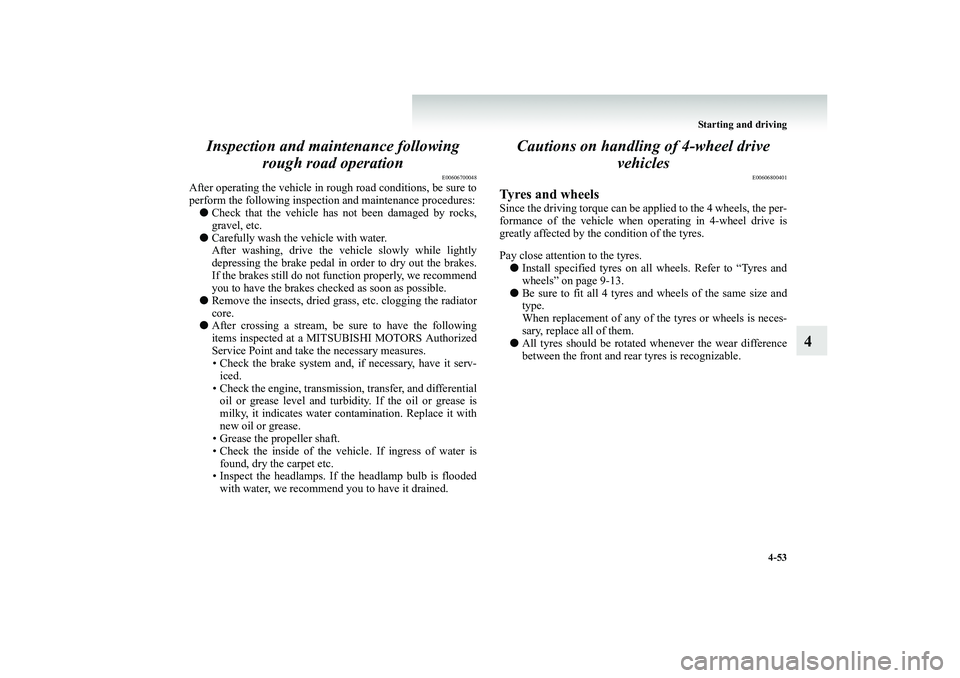
Starting and driving
4-53
4
Inspection and main
tenance following
rough road operation
E00606700048
After operating the vehicle in rough road conditions, be sure to perform the following inspection and maintenance procedures: ●
Check that the vehicle has not been damaged by rocks, gravel, etc.
●
Carefully wash the vehicle with water. After washing, drive the vehicle slowly while lightlydepressing the brake pedal in order to dry out the brakes. If the brakes still do not function properly, we recommend you to have the brakes checked as soon as possible.
●
Remove the insects, dried grass, etc. clogging the radiator core.
●
After crossing a stream, be sure to have the following items inspected at a MITS
UBISHI MOTORS Authorized
Service Point and take the necessary measures. • Check the brake system and,
if necessary, have it serv-
iced. • Check the engine, transmissi
on, transfer, and differential
oil or grease level and turbid
ity. If the oil or grease is
milky, it indicates water co
ntamination. Replace it with
new oil or grease. • Grease the propeller shaft.• Check the inside of the vehi
cle. If ingress of water is
found, dry the carpet etc. • Inspect the headlamps. If th
e headlamp bulb is flooded
with water, we recommend you to have it drained.
Cautions on handling
of 4-wheel drive
vehicles
E00606800401
Tyres and wheelsSince the driving torque can be
applied to the 4 wheels, the per-
formance of the vehicle when
operating in 4-wheel drive is
greatly affected by th
e condition of the tyres.
Pay close attention to the tyres. ●
Install specified tyres on all
wheels. Refer to “Tyres and
wheels” on page 9-13.
●
Be sure to fit all 4 tyres an
d wheels of the same size and
type. When replacement of any of th
e tyres or wheels is neces-
sary, replace all of them.
●
All tyres should be rotated
whenever the wear difference
between the front and rear tyres is recognizable.
BK-BK2008E1ENUK.en-uk-Section7.fm Page
53 Wednesday, January 9, 2008 4:36 PM
Page 259 of 538

Starting and driving
4-57
4
Wa r n i n g l a m p●
The brake warning lamp illuminates to indicate a fault in the braking system. Read “Brake warning lamp” on page 3-13.
●
On vehicles with the rear di
fferential lock, the active sta-
bility & traction control (AST
C) and anti-lock brake sys-
tem (ABS) functions are
suspended while the rear
differential lock is activat
ed. ASTC indication lamp,
active stability control function OFF indication lamp, ABS warning lamp and brake warning lamp are illumi- nated while these functions are suspended. It does notindicate a problem. When the re
ar differential lock is dis-
engaged, these lamps go out and function again. Refer to “Brake warning lamp” on page 3-13, “ABSwarning lamp” on page 4-60, “ASTC indication lamp” on page 4-64, “Active stability control function OFF indica- tion lamp” on page 4-67.
When brakes are wetCheck the brake system while dr
iving at a low speed immedi-
ately after starting, especially wh
en the brakes are wet, to con-
firm they work normally. A film of water can be formed
on the brake discs and prevent
normal braking after driving in heavy rain or through largepuddles, or after the vehicle is washed. If this occurs, dry the brakes out by driving slowly while lightly depressing the brake pedal.When driving downhillIt is important to take advantage of the engine braking by shift-ing to a lower shift position while driving on steep downhill roads in order to prevent th
e brakes from overheating.
WARNING
!●
Never coast downhill with
the engine OFF. Keep the
engine running whenever your
vehicle is in motion.
If you turn off the engine
while driving, the power
brake booster will stop
working and your brakes
will not work as well.
●
If the power assist is lost
or if either brake hydraulic
system stops working properly, have your vehicle checked immediately.
WARNING
!●
Do not leave any objects near the brake pedal or let a floor mat slide
under it; doing so could prevent the
full pedal stroke that would be necessary in an emer-gency. Make sure that the pedal can be operated freely at all times. Make sure the floor mat is securely held in place.
BK-BK2008E1ENUK.en-uk-Section7.fm Page
57 Wednesday, January 9, 2008 4:36 PM
Page 263 of 538
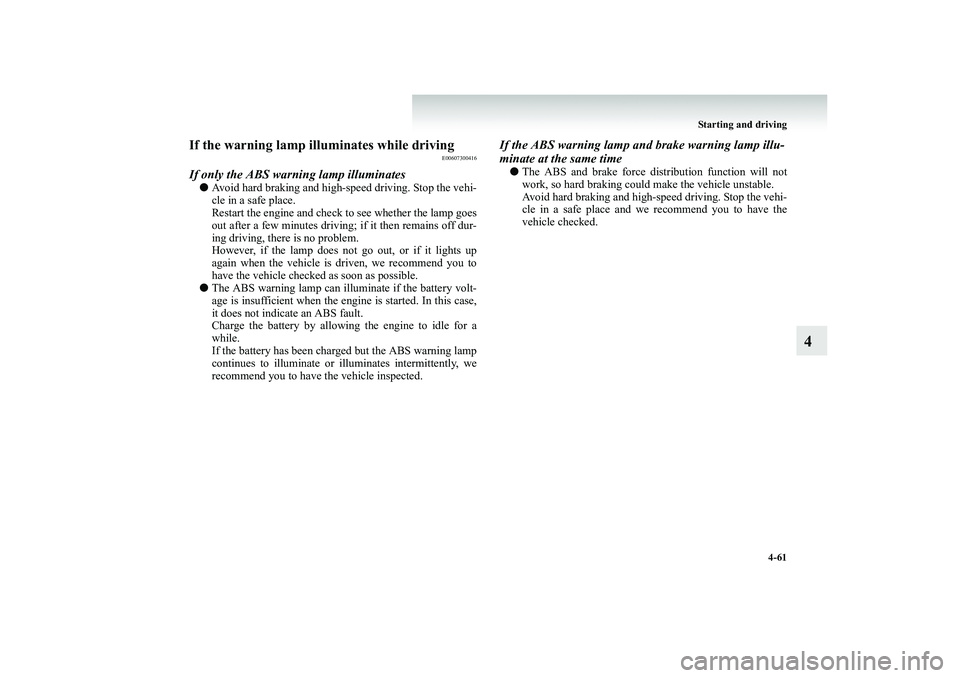
Starting and driving
4-61
4
If the warning lamp illuminates while driving
E00607300416
If only the ABS warning lamp illuminates●
Avoid hard braking and high-speed driving. Stop the vehi- cle in a safe place. Restart the engine and check to see whether the lamp goesout after a few minutes driving; if it then remains off dur- ing driving, there is no problem. However, if the lamp does not go out, or if it lights upagain when the vehicle is driven, we recommend you to have the vehicle checked as soon as possible.
●
The ABS warning lamp can illuminate if the battery volt- age is insufficient when the en
gine is started. In this case,
it does not indicate an ABS fault. Charge the battery by allowing the engine to idle for awhile. If the battery has been charged but the ABS warning lamp continues to illuminate or illuminates intermittently, werecommend you to have the vehicle inspected.
If the ABS warning lamp and brake warning lamp illu- minate at the same time●
The ABS and brake force distribution function will not work, so hard braking could make the vehicle unstable. Avoid hard braking and high-speed driving. Stop the vehi- cle in a safe place and we recommend you to have thevehicle checked.
BK-BK2008E1ENUK.en-uk-Section7.fm Page
61 Wednesday, January 9, 2008 4:36 PM
Page 304 of 538
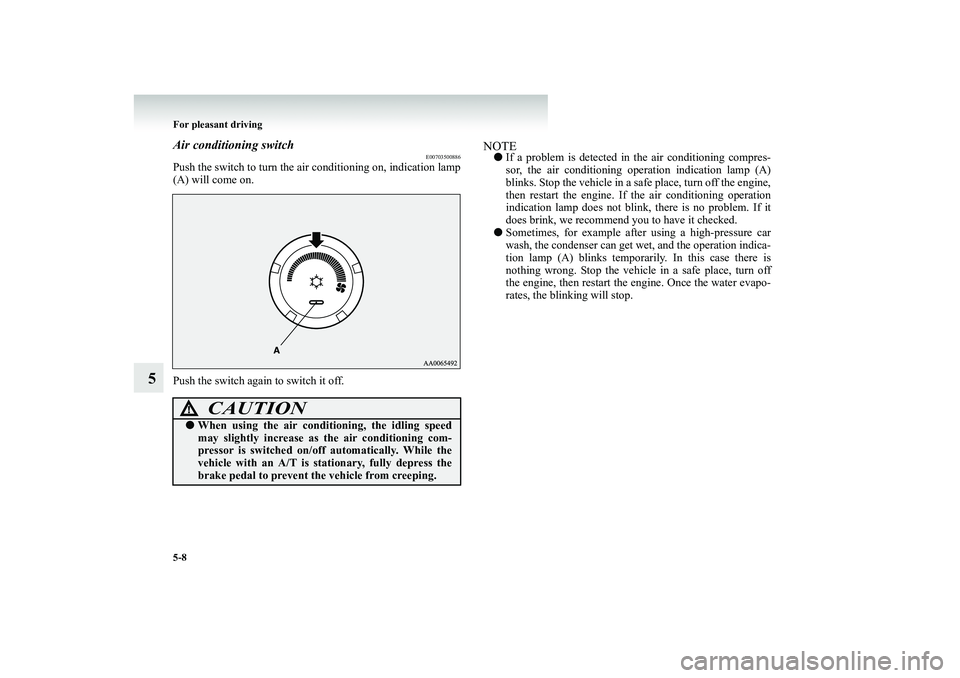
5-8 For pleasant driving
5
Air conditioning switch
E00703500886
Push the switch to turn the air conditioning on, indication lamp (A) will come on. Push the switch again to switch it off.
NOTE●
If a problem is detected in
the air conditioning compres-
sor, the air conditioning operation indication lamp (A) blinks. Stop the vehicle in a sa
fe place, turn off the engine,
then restart the engine. If the air conditioning operationindication lamp does not blink, there is no problem. If it does brink, we recommend you to have it checked.
●
Sometimes, for example afte
r using a high-pressure car
wash, the condenser can get we
t, and the operation indica-
tion lamp (A) blinks temporarily. In this case there is nothing wrong. Stop the vehicl
e in a safe place, turn off
the engine, then restart the
engine. Once the water evapo-
rates, the blinking will stop.
CAUTION
!●
When using the air condit
ioning, the idling speed
may slightly increase as
the air conditioning com-
pressor is switched on/off
automatically. While the
vehicle with an A/T is st
ationary, fully depress the
brake pedal to prevent th
e vehicle from creeping.
BK-BK2008E1ENUK.en-uk-Section8.fm Page 8 Wednesday, January 9, 2008 4:41 PM
Page 378 of 538
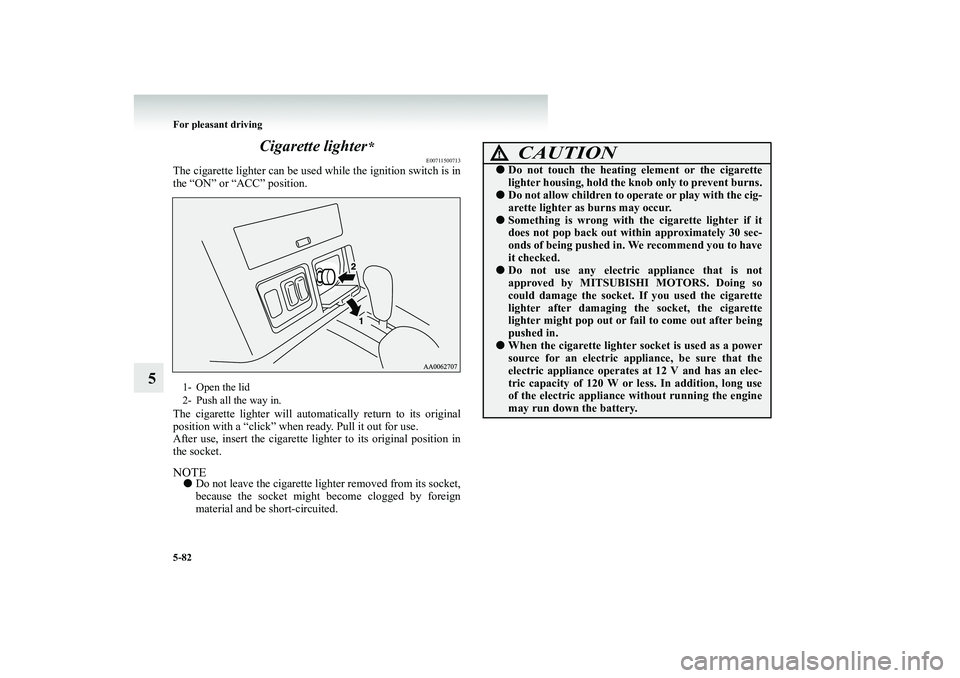
5-82 For pleasant driving
5
Cigarette lighter
*
E00711500713
The cigarette lighter can be used
while the ignition switch is in
the “ON” or “ACC” position. The cigarette lighter will automatically return to its original position with a “click” when ready. Pull it out for use. After use, insert the cigarette lighter to its original position inthe socket.NOTE●
Do not leave the cigarette light
er removed from its socket,
because the socket might
become clogged by foreign
material and be short-circuited.
1- Open the lid 2- Push all the way in.
CAUTION
!●
Do not touch the heating
element or the cigarette
lighter housing, hold the kn
ob only to prevent burns.
●
Do not allow children to op
erate or play with the cig-
arette lighter as burns may occur.
●
Something is wrong with th
e cigarette lighter if it
does not pop back out wi
thin approximately 30 sec-
onds of being pushed in.
We recommend you to have
it checked.
●
Do not use any electric
appliance that is not
approved by MITSUBISHI MOTORS. Doing so could damage the socket. If
you used the cigarette
lighter after damaging th
e socket, the cigarette
lighter might pop out or fail to come out after beingpushed in.
●
When the cigarette lighter so
cket is used as a power
source for an electric app
liance, be sure that the
electric appliance operates
at 12 V and has an elec-
tric capacity of 120 W or less. In addition, long use of the electric appliance
without running the engine
may run down the battery.
BK-BK2008E1ENUK.en-uk-Section8.fm Page
82 Wednesday, January 9, 2008 4:41 PM
Page 447 of 538
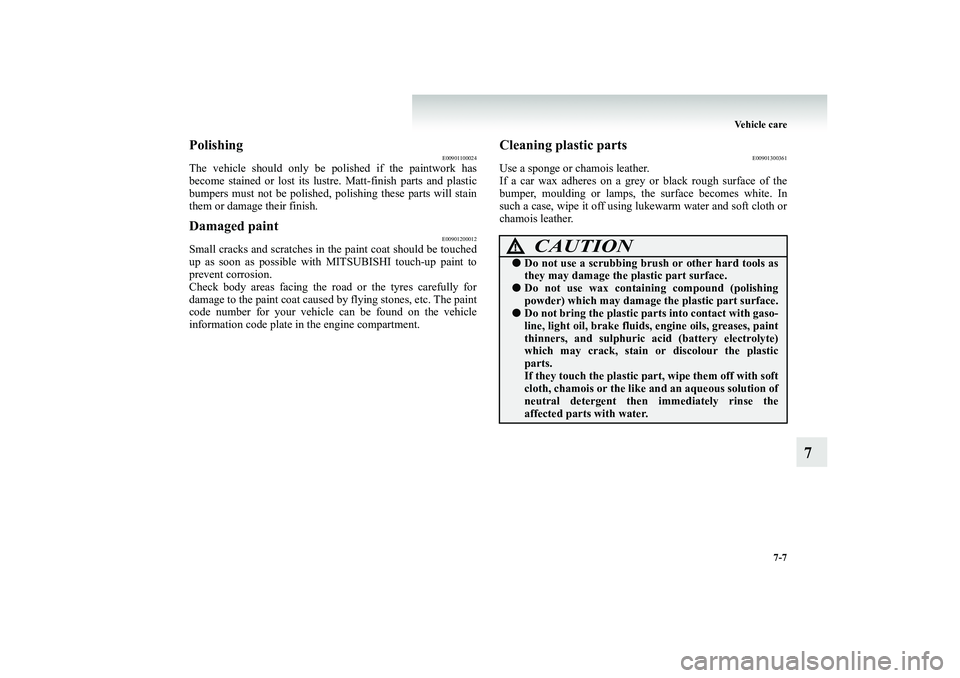
Vehicle care
7-7
7
Polishing
E00901100024
The vehicle should only be polished if the paintwork has become stained or lost its lustre. Matt-finish parts and plastic bumpers must not be polished, polishing these parts will stain them or damage their finish.Damaged paint
E00901200012
Small cracks and scratches in the paint coat should be touched up as soon as possible with
MITSUBISHI touch-up paint to
prevent corrosion.Check body areas facing the road or the tyres carefully for damage to the paint coat caused by
flying stones, etc. The paint
code number for your vehicle can be found on the vehicleinformation code plate in
the engine compartment.
Cleaning plastic parts
E00901300361
Use a sponge or chamois leather. If a car wax adheres on a grey
or black rough surface of the
bumper, moulding or lamps,
the surface becomes white. In
such a case, wipe it off using lukewarm water and soft cloth orchamois leather.
CAUTION
!●
Do not use a scrubbing brush or other hard tools as they may damage the plastic part surface.
●
Do not use wax containi
ng compound (polishing
powder) which may damage
the plastic part surface.
●
Do not bring the plastic part
s into contact with gaso-
line, light oil, brake fluids, engine oils, greases, paint thinners, and sulphuric ac
id (battery electrolyte)
which may crack, stain or
discolour the plastic
parts. If they touch the plastic pa
rt, wipe them off with soft
cloth, chamois or the like
and an aqueous solution of
neutral detergent then
immediately rinse the
affected parts with water.
BK-BK2008E1ENUK.en-uk-Section10.fm Page
7 Wednesday, January 9, 2008 4:48 PM